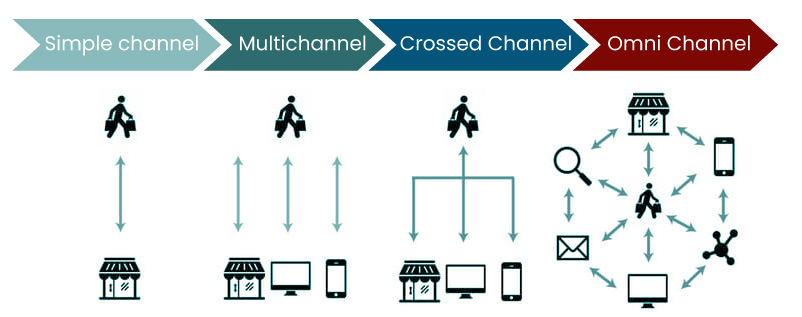Multichannel, cross channel, omnichannel… are terms that we often hear.
But what is the real promise behind this?
If multi-channel indicates a multiplication of touchpoints acting independently of each other and cross-channel describes the situation where all touchpoints are integrated into the company’s customer journey, what does omnichannelity mean? What are the advantages of implementing it in your company? Is this a real competitive advantage for my brand? Let’s discover the answers to these essential questions together.
What does omnichannel mean?
It is with the development of new technologies that sales strategies have been revolutionised. Digital has pushed brands to think about new ways of selling their products/services.
Among these new methods, we find omnichannelity. This strategy is based on the creation of a single consumption universe bringing together all distribution channels (stores, e-commerce sites, marketplace, etc.).
Omnichannel is not just the coordination of all these sales channels, the objective is to create synergy to form a single customer experience. This approach places the customer at the centre of the strategy, emphasising their satisfaction and loyalty. Omnichannel is therefore a response to the expectations of modern consumers, who are looking for a hassle-free and personalised purchasing experience, regardless of the channel used.

How to manage omnichannelity?
In order to keep the promise of a single customer journey, the company that offers several sales channels for its products must have an omnichannel solution that allows it to manage them in a unified way.
To do this, it can equip itself with software like LM ERP which, thanks to all its connectors, meets the promise of unified commerce.
- In-store sales: The LM Retail application, connected to the LM ERP back office, makes physical collections more fluid, at permanent points of sale or in pop-up stores. All data from in-store sales is centralised in the same back office and shared between all profit centres (catalogue, stock, directory, etc.).
- Sales from e-commerce sites: LM ERP thanks to its connectors to the main e-commerce platforms on the market (Prestashop, Magento, NewOxatis, Shopify, etc.), centralises orders on a single tool, avoids multiple catalogue entries and instantly updates product stock.
- Sales from marketplaces: LM ERP allows you to distribute part or all of your catalogue on marketplaces, without re-entry. The management of your products on marketplaces is then done in a completely transparent and secure manner. Here too, the software can synchronise all the information that comes from the marketplaces.
These management solutions can allow the retailer to offer its consumers a personalised experience because it does not matter where they look for the information (in a store or on an e-commerce site).
They will be able to pick up their order at a point of sale or have it delivered, and pay from home or directly at the point of sale.
What are the advantages of omnichannel management?
Sales development
The brand’s presence on several channels helps to increase its visibility and develop its turnover.
Thanks to online commerce in particular, it can reach customers that it would not have reached if it only sold at physical points of sale. This was even accentuated during the Covid-19 health crisis.
A FEVAD study (E-commerce and distance selling federation) showed that during the second 2020 lockdown, it was the store brands that recorded the strongest growth (+175%), when the pace of pure players was 6 times slower. This shows the benefit of combining different channels, for example online sales and in-store sales. *
Enrichment of the purchasing experience
Reducing points of friction between in-store and online leads to a better customer experience, promoting consumer commitment and satisfaction.
Indeed, a fluid and harmonious interconnection between all of the company’s sales channels allows the customer to benefit from a personalised and stress-free purchasing journey. Some examples of omnichannel purchasing journeys:
- He can either opt for a traditional act of purchasing: “I go to the store, I take my item, I pay for it at the checkout”
- He can also decide to opt for Click & Collect: “I choose my item online, I pay for it and I decide to have it delivered to the store”
- He may also opt for home delivery: “I buy my product either in store or on the Internet and I decide to have it delivered to my home”
Customer loyalty
The implementation of omnichannel tools allows you to deepen your knowledge of your customer by collecting data. All of the information obtained will allow marketing to better target customer needs.
This data then makes it possible to offer communication as well as a personalised customer experience, this is what we call clienteling.
Optimisation of internal processes
Omnichannel management makes it possible to optimise a company’s internal processes.
By centralising information and synchronising data between different sales channels and points of sale in a network, teams can collaborate more effectively.
This results in better inventory management, more accurate order planning, logistics optimisation and reduced operational costs.
Improved customer support
Thanks to omnichannelity, the company benefits from greater responsiveness and improved customer service.
Customers can interact with the brand through different channels: in-store, online, by telephone, on social networks. This means they benefit from fast and consistent support regardless of the channel they use.
These different ways of interacting make it possible to effectively resolve problems and respond to customer questions and requests proactively, thus strengthening their satisfaction and loyalty.
Are you ready to enter the era of unified commerce?
In conclusion, initially reserved for the largest brands, omnichannelity is today within the reach of any business that wishes to go digital, improve its management and enrich its customer experience.
By adopting an omnichannel approach, businesses grow their sales by increasing their visibility and reaching a wider customer base through different channels.
Omnichannelity is reflected through different actions that promote customer loyalty by collecting data and offering a personalised customer experience, thus strengthening the relationship between the consumer and the brand. In short, omnichannel management of a business represents an important competitive advantage, allowing them to remain competitive in an ever-changing environment and meet growing consumer expectations.
More information about LUNDI MATIN omnichannel solutions:

